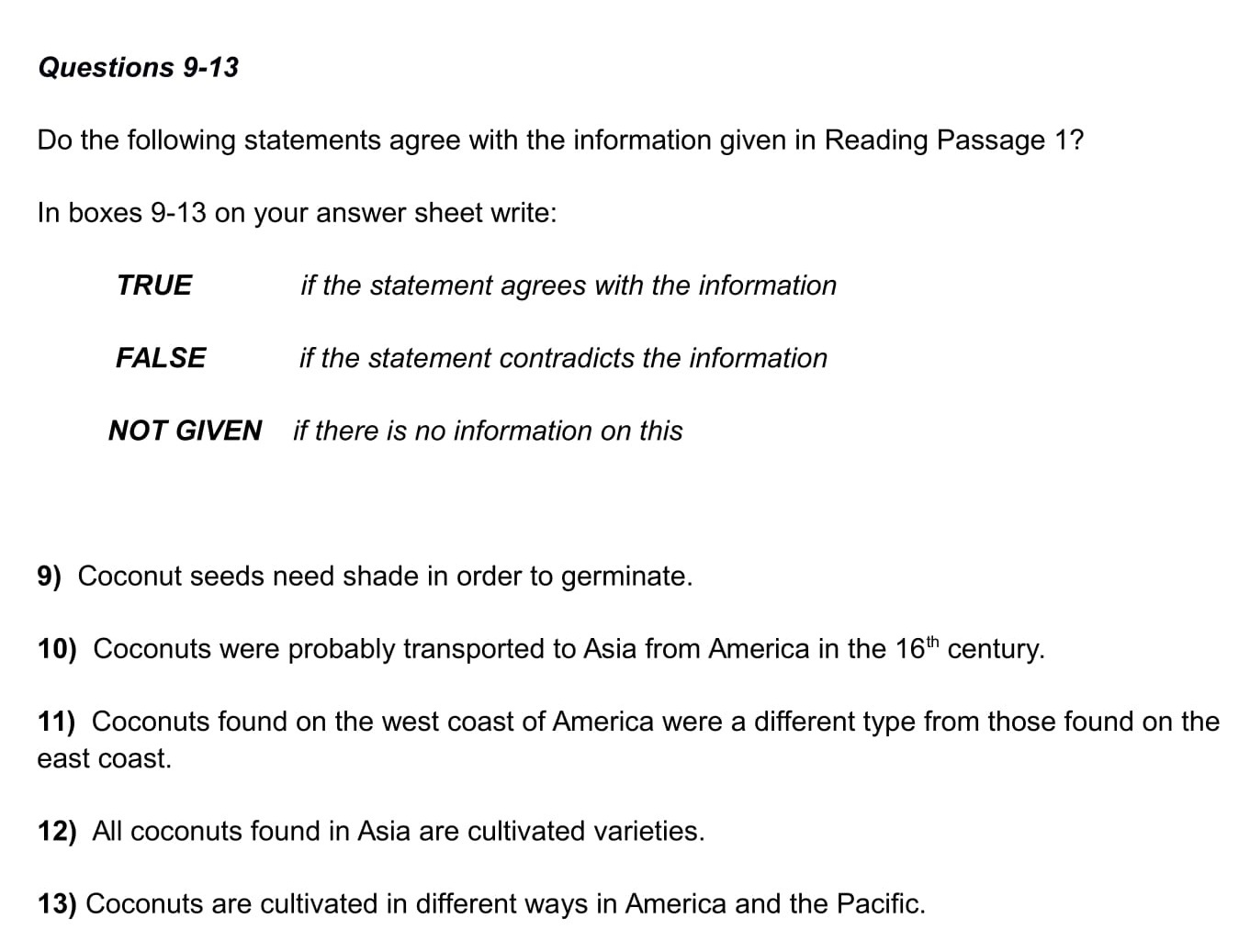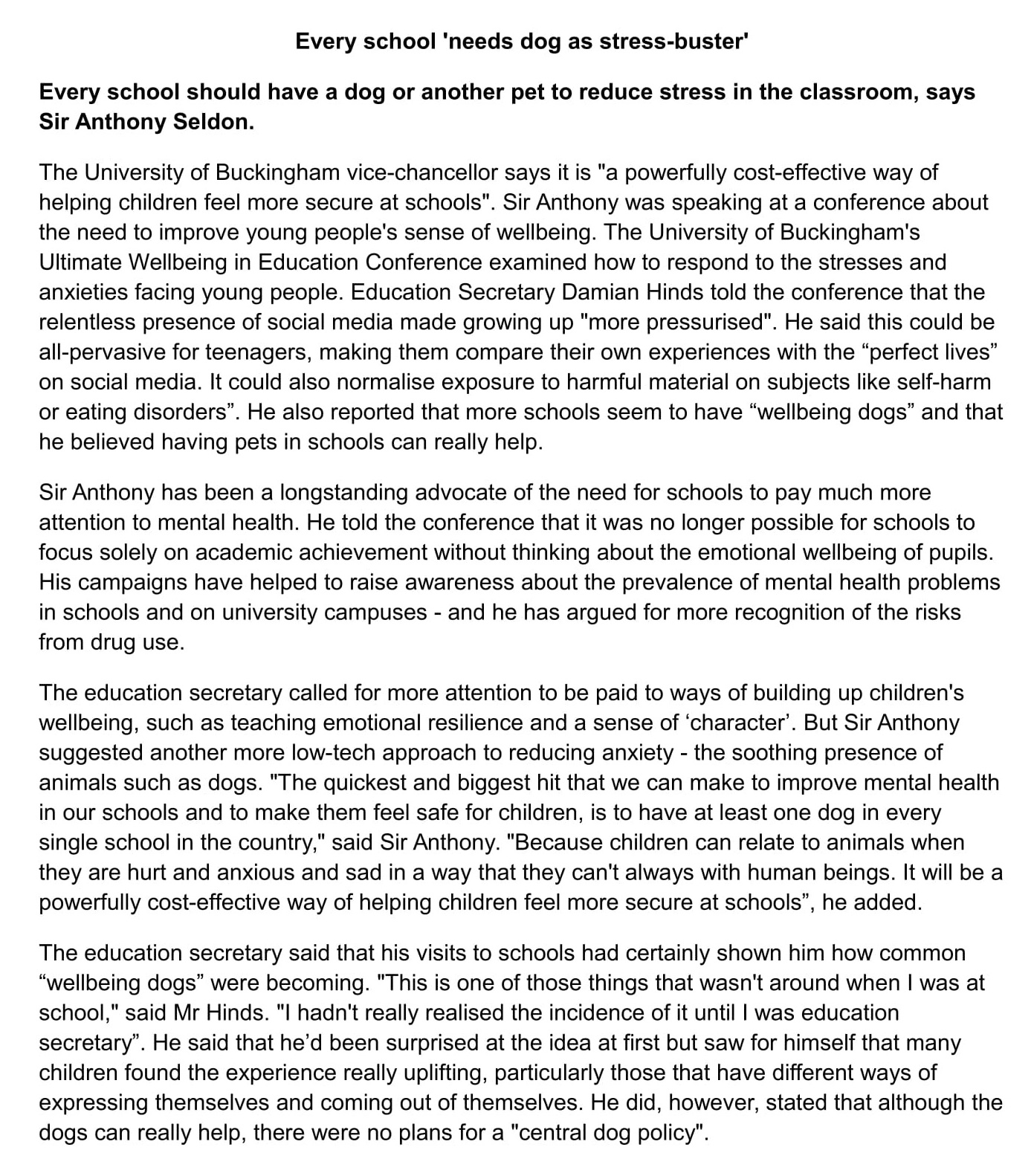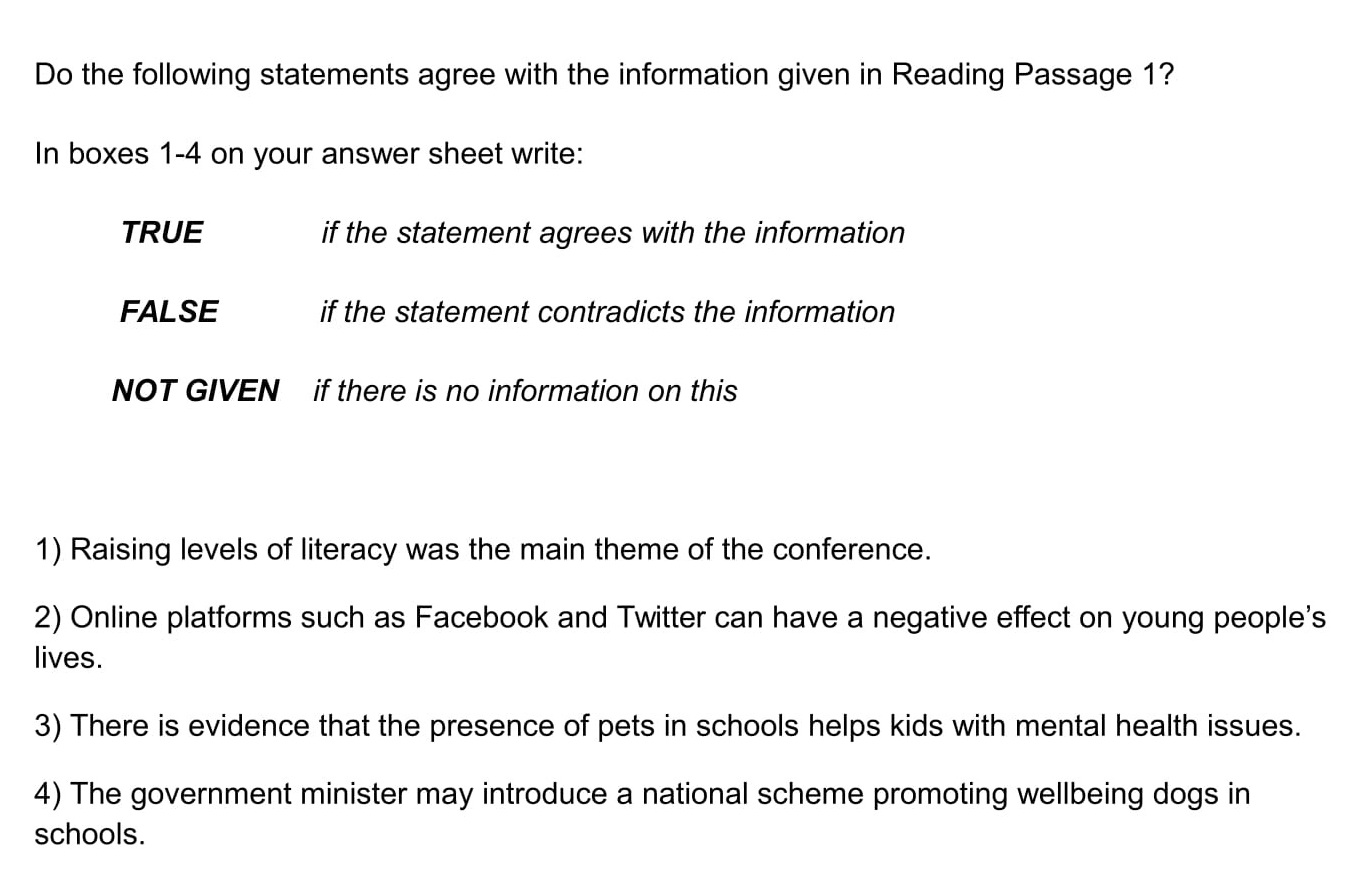What Guided Reading Level Is Too Many Dogs
IELTS Reading
True, Simulated, Not Given Questions
Truthful, Simulated, Not Given questions come upwardly regularly in the IELTS Reading test.
Many students fear this blazon of question and I'll explicate why in a minute. However, if yous learn the tips and exercise the strategy on this page, you'll soon improve your skill at answering them.
Here'due south what we'll exist roofing:
- Caption
- The big challenge
- Divergence betwixt T/F/NG & Y/Due north/NG questions
- eight Top tips
- Proven strategy
- Examples & model answers
Explanation
For True/False/Not Given questions, you lot will be given a set of statements and a text. Your task is to determine which of the post-obit applies to the information in each statement:
- it agrees with the information in the text – TRUE (T)
- it disagrees with it or contradicts it – Fake (F)
- information technology is not mentioned in the text – NOT GIVEN (NG)
Here's a set of sample instructions & questions from a existent past IELTS Reading exam paper for illustration.

So, you need to do two things:
one) Empathise the information in the statements.
2) Make up one's mind if it is Truthful, False or Not Given according to the text.
The big challenge
The challenge with a T/F/NG type question is that for some statements, the Non GIVEN ones, you will be searching for information that'snot there.
This is the first reason why some people fright it.
It's very easy to waste product a huge amount of time going over and over the text to bank check that you lot oasis't missed the information.
The 2d challenge is the unfamiliarity of this blazon of question. Nigh people will have looked for TRUE & Fake statements in a text back in their school days only may have no feel of NG statements.
Hence, it's actress important to have a strategy that gives you the confidence to brand your decision and move swiftly on.
Difference between True/False/Non Given & Yep/No/Not Given questions
Some students go dislocated betwixt True/Simulated/Non Given questions and Yes/No/Non Given questions and so I'll quickly explicate the difference.
It's all most the type of information contained in the text.
Truthful/False/Non Given –the text will incorporatefactual data near a topic.
Yes/No/Not Given –the text will incorporate theopinions, views or beliefs of the writer or other people who are mentioned.
8 Height tips
i) The answers appear in the same order in the text as the order of the statements.
2) Y'all don't need to read the whole text. First, y'all will browse for keywords and so y'all'll read in detail the section in which they're located for the answer.
3) There will exist at least one of each reply blazon – True, Fake, Not Given. So, if yous don't have at least ane of each when yous've completed the question, y'all've made a error.
4) Watch out for distractors. Be aware that the test setters love to use 'distractors' to really test you. A prime case is qualifying words such as:
every a few
all always
some often
nigh occasionally
These single words can completely change the meaning of a sentence.
E.g. Tiantian often meets upwards with her friends after work.
Tiantian occasionally meets upwards with her friends after piece of work.
In T/F/NG questions, the significant of the statement must be an exact match with the information in the text to be TRUE.
5) Also exist on the picket for qualifying words that express possibility or incertitude such as:
seem claim
suggest perchance
believe probably
Over again, they can totally modify the pregnant of a statement.
Due east.one thousand. Scientists at present claim that several different species of humans evolved on the earth.
Scientists at present know that several unlike species of humans evolved on the earth.
6) The statements won't be a word-for-word friction match to the data in the text. They volition comprise synonyms and paraphrasing. Information technology's the meaning that you lot are trying to lucifer.
seven) The test is not an assessment of your knowledge of the topic but only of your ability to read and understand the specific information in the text. Then, if you lot happen to know from your own knowledge that a particular argument is correct, i.east. TRUE, only this is not stated in the text, your respond must be NOT GIVEN.
eight) Remember that at least one reply volition be NG. This means that you will be searching for data that is not there.
As already mentioned, information technology's easy to waste time searching and searching for information you're never going to find considering it isn't there. Apply the strategy I'm about to testify you to quickly come to a decision about each statement and move on.
The Strategy
# i Read the instructions carefully. Double-bank check whether information technology is a Truthful/FALSE/NOT GIVEN or a YES/NO/Not GIVEN question.
# 2 Read the statements and endeavor to sympathise the significant of each. Do this before reading the text.
# iii Recollect about possible synonyms that might appear in the text and note any qualifying words in the statements such as, all, some, always, frequently. This will make your brain alerts for them when you scan the text.
# 4 Underline keywords. You won't necessarily discover the exact words in the text due to the extensive use of synonyms and paraphrasing in T/F/NG questions but enough will be nowadays to make doing this worthwhile.
# 5 Re-read argument 1 and browse the start paragraph, maybe ii, for the keywords or synonyms of them. Scanning will locate where the answer is but detailed reading of this department of the text is now needed to decide if the specific information y'all're looking for is TRUE, FALSE or NOT GIVEN.
# 6 Make your decision. Remember to consider these three things:
- To be TRUE, the information must exactly match even if the words are different.
- Expect carefully for qualifying words that might change the meaning.
- If y'all are struggling to find the answer information technology's probably considering information technology isn't there, i.eastward. it's Non GIVEN.
# 7 Repeat this process for the remaining questions.
Example with answers
Please note that this case is non from a real IELTS Reading examination paper. I take created it myself to demonstrate the strategy I've merely outlined and to give you an opportunity to practice it.
The text in your test volition be longer and probably accept 5 or vi statements.
Follow steps ane-7 of the strategy and run across if you lot can work out if each statement is True, False or NOT GIVEN. So read my notes beneath which contain the answers.

Download the PDF of this text – Reducing Stress in the Classroom

Download the PDF of these instructions – Reducing Stress in the Classroom - Statements
Notes on how I answered the questions
one) Having read the instructions and tried to empathize the meaning of the statements, I at present focus in on the first statement.
one. Raising levels of literacy was the main theme of the conference .
The keyword I select to browse for is conference . I'k adequately certain I'll find this or a synonym because information technology has an article word in front end of it (the) which makes it the field of study of the sentence.
I will and then demand to search the text to meet if 'raising levels of literacy' actually was the master theme of this briefing.
I scan the first main paragraph and find 'conference' twice. I read both sentences that comprise it in detail.
Sir Anthony was speaking at a conference well-nigh the need to meliorate young people'due south sense of wellbeing. The University of Buckingham'due south Ultimate Wellbeing in Education Conference examined how to answer to the stresses and anxieties facing young people.
It is very clear that the conference was about the wellbeing of the pupils, non their level of literacy. The reply is thereforeFALSE.
2) Adjacent, I read the second statement and make up one's mind to scan for words connected to the internet equally this is what the statement is most.
two. Online platforms such as Facebook and Twitter can accept a negative effect on young people's lives.
I continue scanning from the location of the final answer. Remember, the information will come in lodge in the text.
I speedily spot the words 'social media' which appear twice. I read the two sentences in detail to look for any matching words or phrases. I also see the word 'teenagers' which is a synonym of 'young people'. This is some other clue that at that place is a match of information.
Education Secretary Damian Hinds told the conference that the relentless presence of social media made growing up "more pressurised". He said this could exist all-pervasive for teenagers , making them compare their ain experiences with the "perfect lives" on social media .
However, I now need to decide if the specific data in the text matches that of the statement.
The diction is very different but the text definitely states that social media, of which Facebook and Twitter are a major role, tin have a negative effect on immature people's lives.
So, the statement is TRUE.
three) Moving on to statement iii, I re-read it to ensure I understand the meaning then cull my keywords, in this case, 'pets' and 'mental health'. I then browse for these.
iii. There is evidence that the presence of pets in schools helps kids with mental health bug.
I hands find 'mental wellness' merely there is no mention of 'pets' in this part of the text. I do, all the same, spot the words 'animals' and 'domestic dog' which might have been used to paraphrase 'pets'.
I read in detail to get the meaning of the text.
But Sir Anthony suggested another more low-tech approach to reducing feet - the soothing presence of animals such equally dogs . "The quickest and biggest hit that we can make to ameliorate mental health in our schools and to make them experience safe for children, is to have at least one domestic dog in every unmarried school in the country," said Sir Anthony. "Because children can relate to animals when they are hurt and broken-hearted and sad in a way that they tin't always with human beings. It volition be a powerfully price-effective way of helping children feel more secure at schools", he added.
It seems to match the data in the judgement but at that place is another very of import keyword in the statement that I need to consider – ' evidence '. This ways proof of the thought being suggested.
While the ideas lucifer, there is no straight evidence stated so I mark the respond NOT GIVEN.
Y'all can see why NG answers can be challenging.
4) Moving on to the terminal statement, I select 'government government minister' and 'national scheme' every bit my keywords and continue scanning the rest of the text for them. In this instance, this means the final paragraph.
4. The government government minister may introduce a national scheme promoting wellbeing dogs in schools.
I don't find either of these phrases in the text then need to remember about possible synonyms. Even if I know fiddling about politics, I can guess that the 'education secretary' is a 'government minister'. So that'due south a commencement.
The education secretary said that his visits to schools had certainly shown him how common 'wellbeing dogs' were becoming. "This is one of those things that wasn't around when I was at school," said Mr Hinds. "I hadn't really realised the incidence of it until I was education secretarial assistant ". He said that he'd been surprised at the thought at first simply saw for himself that many children found the experience really uplifting, especially those that have unlike ways of expressing themselves and coming out of themselves. He did, however, stated that although the dogs can really help, in that location were no plans for a "fundamental dog policy ".
I browse over again looking out for whatever other words related to authorities and politics and in the terminal sentence I also spot the discussion 'policy'.
Information technology doesn't matter if you don't empathize what this word means. All that matters is that you can work out from the context of the sentence that this word is probably relevant and indicates where the respond is located.
I make an educated guess that a 'central dog policy' is a lucifer for a 'national scheme promoting wellbeing dogs in schools', and re-read the sentence to observe my answer.
The sentence states that there are 'no plans for a central canis familiaris policy', so the reply is Imitation.
Answers
1 FALSE
2 True
3 NOT GIVEN
4 Imitation
Want to picket the video of this page? Click here.
I promise yous've found this page helpful. Yous are now set to practice this strategy with past test papers. Once you go the hang of answering T/F/NG questions, you'll be able to tackle them with confidence in your IELTS Reading examination.
Like this page?
Lessons On All Question Types
For more sample questions with step-by-step instructions, run into theIELTS Reading menu page.
- Domicile ›
- IELTS Reading ›
- True/False/Not Given
-
Dorsum To Top
Source: https://www.ieltsjacky.com/ielts-reading-true-false-not-given.html
0 Response to "What Guided Reading Level Is Too Many Dogs"
Post a Comment